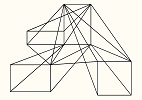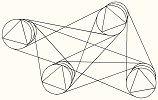


 |
 |  |
The measurement of Joule's constant was faked in 1845 producing a false definition of energy which corrupts 90% of physics. Joule stirred water in a wooden bucket for an hour or two (not stated) and supposedly measured the temperature increase. He didn't have the slightest ability to conduct such an experiment, as the slight amount of heat produced would have disappeared into the environment as fast as it was produced. Then there were no correct theoretical concepts for his purpose. Physicists assume that Joule's constant defines kinetic energy by showing the relationship between heat and kinetic energy and that the measurement of Joule's constant shows that heat transforms into ½mv², not mv. The first problem is that it takes more than one data point to determine the correct equation for representing kinetic energy, because variations need to be compared, while Joule-type experiments only produce one point of measurement. The definition of energy is, that which is conserved during interactions. The test of conservation is to create variation and see which representation stays the same. To measure staying-the-same during variations requires more than one data point. The second problem is that Joule could not separate elastic force from inelastic force. Only inelastic force creates heat. (Explained Below) There is no real Joule's constant. The number stems from illusion, as often occurs when allowing perception to contradict logic.
James P. Joule supposedly measured the constant in 1845. In actuality, he did not have the slightest ability to make such a measurement. Joule claimed to have stirred water in a wooden bucket and measured the heat produced. The kinetic energy was said to be determined by weights which were dropped to turn a paddle in the water. There were no thermal constants at that time to determine where the heat was going. Joule was producing such a minuscule amount of heat that it would have dissipated into the environment in a few seconds. Yet his error was supposedly only a few parts per thousand (ppt). He did not describe the details in his brief publication. What he said was that he dropped the weights 12 yards (11m, 36 ft), rewinding and dropping them 16 times for each measurement of temperature. The temperature increase was supposedly 0.5°F or less. The weights were four pounds each, and two were used for balance. The rate of decent was said to be one foot per second. It would have taken two athletes at least 39 minutes per measurement. The numbers are these: Dropping was 36 seconds each times 16, which equals 576 seconds or 9.6 minutes. Rewinding would have taken at least four times as long, which is 38.4 minutes. With a few seconds between events, it would have been at least 39 minutes per measurement. Joule was not a physicist. He mimicked what physicists were doing. When they ran into problems which they could not solve, Joule claimed to have a gimmick for solving them. To account for environmental influences, he dropped weights an extra time. Here's the way he said it: "A series of nine experiments were performed in the above manner, and nine experiments were made in order to eliminate the cooling or heating effects of the atmosphere." Nothing more. There was no way to account for environmental effects experimentally. Another problem is that he had to wind the weights back up sixteen times, and the water would have been stirred while winding. There is no evidence of a slip clutch in photographs of the device, which still exists. Winding up the weights would not have produced a known amount of heat, because the force and energy would vary with velocity. He said he used floats to prevent the water from rotating. Floats would not have been effective. The problem with rotating water is that the weights would drop at an increasing rate as the water rotation increased. The acceleration would reduce force on the cords, and it would add kinetic energy to the weights. The reason why Joule did those things and said those things is because real physicists were trying to do exactly what Joule was doing but failing. So Joule copied them but pretended to be successful. They gave up trying, while Joule ran to a complicit publisher with his lies. It's important to note that the same thing happened with relativity. Real physicists were discussing and rejecting all elements of relativity, while Einstein plagiarized them and got a description published as if it were his own ideas. In other words, frauds don't originate their own ideas; they aren't that intelligent. Einstein was one of the stupidest persons in science, which is why he was working in a patent office, until his frauds were found to be exploitable. There is also a message about publishers in Joule's constant and relativity: It is the publishers and grant providers who shape science, and they have turned modern science into a fraud machine.
The only force Joule was accounting for was the weights being dropped. They would have been producing a combination of elastic and inelastic force in the water. Elastic force acts upon matter to produce stress or acceleration. But heat is only produced by inelastic force. Joule had no method of determining the inelastic force which produces heat. Most of the force would have been elastic force which was not producing heat. How did he get three parts per thousand error when measuring the wrong force as supposedly producing the heat? It's called fraud. Joule's corrupt standards were demonstrated even more dramatically in experiments which he did with an electrical generator before switching to the wooden bucket experiment. He supposedly got the constant within about 10% doing a variety of those experiments. But they defied principles of physics besides being technically impossible. The basic procedure was to put a coil in a test-tube with water and spin it in a magnetic field for fifteen minutes. The kinetic energy on a hand crank was compared to the heat in the water. He used a galvanometer to measure electrical energy. It is a coil with a pointer, and the current flows through it. There were no concepts of volts or amps in those days. So he said he referenced the galvanometer to the blue color of a chemical in a solution. He then used its reading as a fudge factor which he called "unity." One of his errors was that a single instrument will not measure electrical energy. Both volts and amps need to be known. He had no theoretical concepts of what he was measuring. Sometimes he charged batteries. Some of the energy would go into the battery and some would heat the coil. He had no way of determining the energy going into the battery. In one experiment, he said he disconnected the wires and still got the constant. There should have been no force with the wires disconnected. Physicists say Joule must have known what he was doing, because he was only off by 3 ppt from the number they get. His number was 4.2 Joules per calorie; the modern number is 4.1868 Joules per calorie. Instead of the modern measurement justifying Joule's experiments, it is Joule's experiments which tell the truth about the modern measurement. Since Joule did not have suitable theoretical concepts nor the slightest technical ability to produce such a measurement, the number has to be a contrivance. Physicists would say they do actual experiments. It only shows that they too are contrivers. Their methodology now days is not visible, but it seems to be referenced to electrical energy, which allows a very high degree of precision, except that electrical energy is even more difficult to relate to absolute values. When converting mechanical energy into electrical energy, a large amount of heat is lost. Due to this problem, the volt is apparently guessed at for absolute value, though it can be standardized with high precision. Regardless of how they conduct modern experiments, Joule's constant is shown to be a contrivance due to the fact that the definition of energy is shown to be in error through my mathematics. Logic defines knowledge. Producing basic knowledge is the purpose of science. Physicists have been denying that science needs logic, because quantum mechanics and relativity are in conflict with logic. But physicists are wrong. There is no knowledge without logic and no purpose to science besides producing a logic consistent with the laws of nature, which have to have consistent relationships to be functional. Logic means consistent relationships. Reference: Energy: Historical Development of the Concept. R. Bruce Lindsay. 1975.
|
| |||||||||||||||||
 |
 |
 | ||
 |
 |
 |
 |
|||